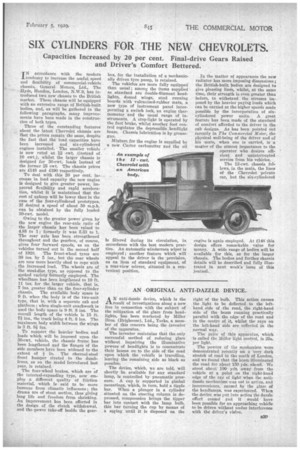AN ORIGINAL ANTI - DAZZLE DEVICE.
Page 23

If you've noticed an error in this article please click here to report it so we can fix it.
.tiA X anti-dazzle device, which is the
result of investigations along a new line in connection with the subject of the mitigation of the glare from headlights, has been marketed by Miller Bros. ,(Brighouse), Ltd., Yorks, a member of this concern being the inventor of the apparatus.
The inventor maintains that the only successful method of reducing glare without impairing the illuminative powers of headlights is to concentrate their beams on to the side of the road upon which the vehicle is travelling, leaving the remaining side as black as possible.
The device, which, we are told, will shortly be, available for any standard lamp, is controlled by pneumatic pressure. A cup is supported in gimbal mountings, which, in turn, hold a tipple bar. When a plunger in a cylinder situated on the steering column is depressed, compression brings the tipper bar into contact with the lamp bulb, this bar turning the cup by means of a spying until it is disposed on the
right of the bulb. This action causes the light to be deflected to the lefthand side of the road, the right-hand side of the beam running practically parallel with the edge' of the road and in the centre of it, whilst the rays on the left-hand side are reflected in the normal way.
The price of this apparatus, which is called the Miller light control, is 25s. per light.
The powers of the mechanism were demonstrated reeently on a -very dark stretch Of road in the north of London, and we found that the beam illuminated the road for about 150 yds. ahead. We stood about100 yds. away from the vehicle at .point an the right-hand edge of the ray, of light when the antidazzle mechanism was not in action, RIO inconvenience,caused, by the glare of the headlamps, was experienced. When the device was put into action the deZzle effect ceased and it would have been possible for an approaching vehicle to be driven Without undue interference with the driver's vision.


































